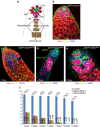The novel tumour suppressor Madm regulates stem cell competition in the Drosophila testis
- PMID: 26792023
- PMCID: PMC4736159
- DOI: 10.1038/ncomms10473
The novel tumour suppressor Madm regulates stem cell competition in the Drosophila testis
Abstract
Stem cell competition has emerged as a mechanism for selecting fit stem cells/progenitors and controlling tumourigenesis. However, little is known about the underlying molecular mechanism. Here we identify Mlf1-adaptor molecule (Madm), a novel tumour suppressor that regulates the competition between germline stem cells (GSCs) and somatic cyst stem cells (CySCs) for niche occupancy. Madm knockdown results in overexpression of the EGF receptor ligand vein (vn), which further activates EGF receptor signalling and integrin expression non-cell autonomously in CySCs to promote their overproliferation and ability to outcompete GSCs for niche occupancy. Conversely, expressing a constitutively activated form of the Drosophila JAK kinase (hop(Tum-l)) promotes Madm nuclear translocation, and suppresses vn and integrin expression in CySCs that allows GSCs to outcompete CySCs for niche occupancy and promotes GSC tumour formation. Tumour suppressor-mediated stem cell competition presented here could be a mechanism of tumour initiation in mammals.
Figures







Similar articles
-
Jak-STAT regulation of cyst stem cell development in the Drosophila testis.Dev Biol. 2012 Dec 1;372(1):5-16. doi: 10.1016/j.ydbio.2012.09.009. Epub 2012 Sep 23. Dev Biol. 2012. PMID: 23010510 Free PMC article.
-
Competitiveness for the niche and mutual dependence of the germline and somatic stem cells in the Drosophila testis are regulated by the JAK/STAT signaling.J Cell Physiol. 2010 May;223(2):500-10. doi: 10.1002/jcp.22073. J Cell Physiol. 2010. PMID: 20143337 Free PMC article.
-
Niche-associated activation of rac promotes the asymmetric division of Drosophila female germline stem cells.PLoS Biol. 2012;10(7):e1001357. doi: 10.1371/journal.pbio.1001357. Epub 2012 Jul 3. PLoS Biol. 2012. PMID: 22802725 Free PMC article.
-
Nutritional regulation of stem and progenitor cells in Drosophila.Development. 2013 Dec;140(23):4647-56. doi: 10.1242/dev.079087. Development. 2013. PMID: 24255094 Free PMC article. Review.
-
Recent advances in Drosophila stem cell biology.Int J Dev Biol. 2009;53(8-10):1329-39. doi: 10.1387/ijdb.072431jp. Int J Dev Biol. 2009. PMID: 19247935 Review.
Cited by
-
Enhancer of polycomb coordinates multiple signaling pathways to promote both cyst and germline stem cell differentiation in the Drosophila adult testis.PLoS Genet. 2017 Feb 14;13(2):e1006571. doi: 10.1371/journal.pgen.1006571. eCollection 2017 Feb. PLoS Genet. 2017. PMID: 28196077 Free PMC article.
-
Merlin and expanded integrate cell signaling that regulates cyst stem cell proliferation in the Drosophila testis niche.Dev Biol. 2021 Sep;477:133-144. doi: 10.1016/j.ydbio.2021.05.012. Epub 2021 May 24. Dev Biol. 2021. PMID: 34044021 Free PMC article.
-
C. elegans DAF-16/FOXO interacts with TGF-ß/BMP signaling to induce germline tumor formation via mTORC1 activation.PLoS Genet. 2017 May 26;13(5):e1006801. doi: 10.1371/journal.pgen.1006801. eCollection 2017 May. PLoS Genet. 2017. PMID: 28549065 Free PMC article.
-
Whole-animal genome-wide RNAi screen identifies networks regulating male germline stem cells in Drosophila.Nat Commun. 2016 Aug 3;7:12149. doi: 10.1038/ncomms12149. Nat Commun. 2016. PMID: 27484291 Free PMC article.
-
The Dlg Module and Clathrin-Mediated Endocytosis Regulate EGFR Signaling and Cyst Cell-Germline Coordination in the Drosophila Testis.Stem Cell Reports. 2019 May 14;12(5):1024-1040. doi: 10.1016/j.stemcr.2019.03.008. Epub 2019 Apr 18. Stem Cell Reports. 2019. PMID: 31006632 Free PMC article.
References
Publication types
MeSH terms
Substances
Grants and funding
LinkOut - more resources
Full Text Sources
Other Literature Sources
Medical
Molecular Biology Databases
Research Materials

